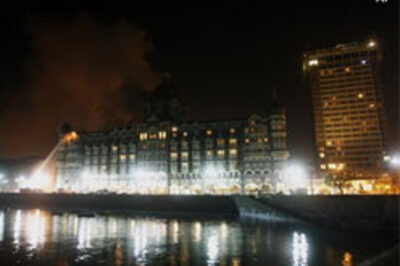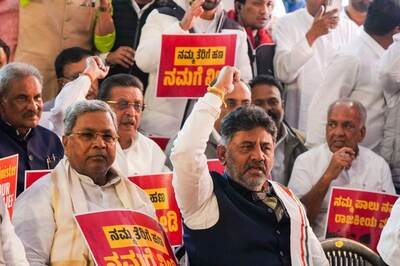
views
Rio De Janeiro: Pandemonium broke out in the shadow of Rio de Janeiro's Maracana stadium on Friday as riot police raided an old museum that authorities want razed ahead of the 2014 World Cup, but where a few indigenous people had squatted for years.
Officers in full riot gear stormed into the dilapidated complex just as a tense, hours-long standoff between the police and about two dozen Indians appeared near a peaceful conclusion.
The Indians had accepted the government's offer to leave the compound in exchange for land on which to build a new settlement in northern Rio de Janeiro and most had already left the site when the officers charged in, prompting fury among the Indians' supporters massed outside the building.
An elderly man in a feather headdress lay collapsed on the sidewalk after police pulled him kicking and screaming from the compound. Protesters and journalists were temporarily blinded after officers fired tear gas and pepper spray and detonated stun grenades in the thick of the crowd.
Protesters streamed into traffic on a nearby busy roadway and lay down in front of cars. Several people were detained. Firefighters turned their hoses on a blaze that broke out inside the compound.
"It was a show of unnecessary force," said Marcelo Freixo, head of the Rio state legislature's Human Rights Commission, who had taken part in the negotiations. "The Indians had agreed to come out and they were coming out.
"It was unnecessary force," Freixo repeated again and again to a scrum of journalists, his eyes streaming from the clouds of tear gas and his face beet red.
Public defender Daniel Macedo said his office was looking into suing the police commander over the use of force.
"It was unfortunate behavior. It was abuse of authority and must be investigated. It did not have to end this way," he told the Globo television network. "Indians had agreed to leave the museum peacefully and in fact several women, children the elderly had left. We asked (police) for another 10 minutes so that all could leave, but before those 10 minutes were up police invaded the museum using tear gas and pepper spray."
Police officials did not reply to requests for comment.
The Indian Museum has been at the center of a protracted legal battle over government plans to demolish it as part of renovations for soccer's 2014 World Cup.
The nearby Maracana stadium will host the tournament's closing match, as well as the opening and closing ceremonies of the 2016 Olympics, and officials have said they intend to turn the area around the stadium into a new parking lot, commercial center and expanded stadium exits.
Small protests broke out when officials evicted residents of a nearby slum for the same projects, and early in 2012, a group called the Homeless Workers Movement organized protests against World Cup preparations in eight of the 12 host cities, briefly stopping work on the stadiums that will host matches in Sao Paulo.
But none of the previous protests turned violent.
A wealthy Brazilian donated the crumbling stone mansion with soaring ceilings to the government in 1847 to serve as a center for the study of indigenous traditions. The museum was abandoned in 1977, and the indigenous squatters, who included men and women of about 10 ethnicities, moved in about a decade ago, building small homes in the complex.
Indians from across Brazil regarded the site as a safe place to stay when they came to Rio to pursue an education, sell trinkets in the streets or get medical treatment, and dozens of people regularly cycled in and out.
The Indians and their supporters had resisted a host of previous attempts to dislodge them, and even after the police surrounded the compound early Friday morning, it was far from clear that they'd end up leaving.
More than two dozen Indians and their supporters, mostly leftist-leaning students and activists, peered over the compound's graffiti-strewn wall to talk with negotiators, as riot police kept journalists and protesters at bay, corralling them into a median between four lanes of rushing traffic. At one point a protester from the feminist group Femen was grazed by a passing car as she bared her breasts to the TV cameras. At another tense moment, a police officer fired a canister of pepper spray over the wall and directly into the Indians' faces.
The ever-growing crowd of supporters outside the complex responded with chants of "fascists, fascists," and "police are the shame of Brazil."
Monica Lima, a 46-year-old teacher who had been protesting outside the police barricade since 5 am, lashed out at Rio state Governor Sergio Cabral, saying officials are using "the World Cup and the Olympics as an excuse to sell this city to a few billionaire businessmen."
In the face of opposition to the Indians' eviction, Cabral told a news conference in October 2012 that the World Cup organizing body FIFA had demanded the building be razed.
However, a letter from FIFA's office in Brazil to the federal public defender's office, published in January by the newspaper Jornal do Brazil, said that the football authority "never requested the demolition of the old Indian Museum in Rio de Janeiro."



















Comments
0 comment